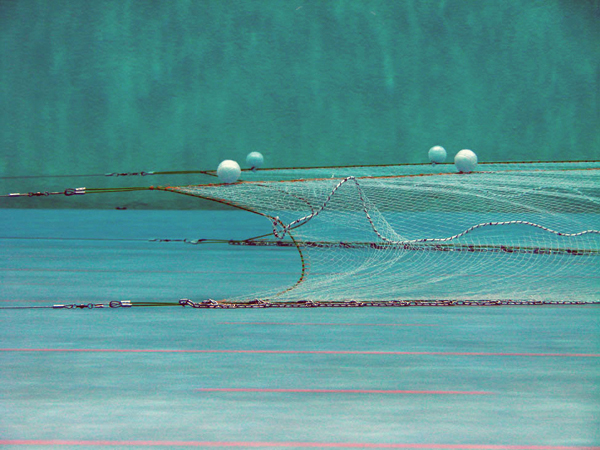In November 2011 New York Sea Grant (NYSG) and the US Geological Survey brought acclaimed expertise in the design of marine trawls to the Cornell University Biological Field Station on Oneida Lake. It was an award-winning partnership that earned co-organizer and NYSG Fisheries Specialist
Dave MacNeill a USGS Great Lakes Science Center Certificate of Appreciation.
MacNeill described the workshop, funded by a Great Lakes Regional Research Information Network grant, as an unprecedented opportunity for a marine-Great Lakes exchange with
Dr. Paul Winger and his internationally-respected fishing gear and marine trawl evaluation team from the Memorial University of Newfoundland’s (MUN) Centre for Sustainable Aquatic Resources.
Dr. Winger directs the MUN’s state-of-the-art facility with the world’s largest indoor flume tank that simulates real-world conditions for the testing of trawls. A week’s worth of testing models in the tank can save months of work on the water with full-size trawls. “We are here to share what we know about fishing gear design and how you can increase both trawl and fuel efficiencies, reduce ecological impacts, and obtain the quality of data you need for fisheries science” Dr. Winger said.
Collecting fish samples with large underwater nets (trawls) provides essential information for understanding food webs and managing valuable fisheries resources. Spring-fall trawls have been cooperatively conducted by U.S. federal and state and Canadian provincial agencies on Lake Ontario since the 1970s.
The MUN Centre works with government and science agencies and commercial fisheries interests and has more than 120 different net/trawl designs and 75 sets of trawl doors for configuration testing.
Dr. Winger, his team members:
George Legge,
Philip Walsh and
Tara Perry; and Great Lakes Science Center Statistician
Jean Adams; presented models, video and data at the workshop that attracted 35 American and Canadian researchers and research vessel personnel representing all five Great Lakes. Some were newcomers to trawling; others have been trawling for 30 years and still want to know more.
“I am impressed with the diversity of responses we received about how important this work is. People are passionate about learning about trawling,” said workshop co-organizer
Dr. Brian Weidel with the USGS Great Lakes Science Center, Oswego, NY.
NYSDEC Research Biologist (and former NY Sea Grant Scholar)
Mike Connerton Cape Vincent, NY, said, “The mussels in Lake Ontario have forced us to change the gear we use. We are looking for the very best data so we can anticipate the fishery 30 years into the future.”
Gary Czypinski of US Fish & Wildlife Service in Ashland, Wisconsin came to learn a technique for catching Asian carp which have the ability to evade the trawl.
Michael Keir of Environment Canada came to learn how the mechanics of trawling can be used to study contaminants in fish populations.
The three-day intensive workshop included hands-on trawl exhibits that filled a yard at the Biological Station and classroom time on design configurations, hydrodynamics, fish behavior impact on catch efficiency, environmental variability, and new opportunities for evaluating trawl designs for use in the Great Lakes.
Dr. Brian F. Lantry, director of the USGS Lake Ontario Biological Station at Oswego, NY, called this workshop “the best and most useful I have ever attended. This type of work makes a realistic, practical contribution to science.” Said MacNeill, “The trawl program well-illustrated NYSG’s commitment to providing sound scientific information and its ability to form effective partnerships among agencies and the research community. Scientists from the USGS Biological Station worked hand-in-hand with us to bring this workshop to fruition.”
New York Sea Grant has provided leadership in educating fisheries researchers and assessment biologists about trawl design and dynamics in the Great Lakes and abroad. After a 2008 workshop organized by NYSG with MUN and Rhode Island Sea Grant,
Dr. Tomas Juza from the University of Southern Bohemia’s Hydrobiology Institute, returned to the Czech Republic where he applied the training to designing a new trawling vessel and trawl now in use there and in several other European Union countries.
– Kara Lynn Dunn

The November trawl workshop featured trawl scale models such as this one being tested in the Memorial University of Newfoundland flume tank, the largest in the world.
Photo by MUN Centre for Sustainable Aquatic Resources